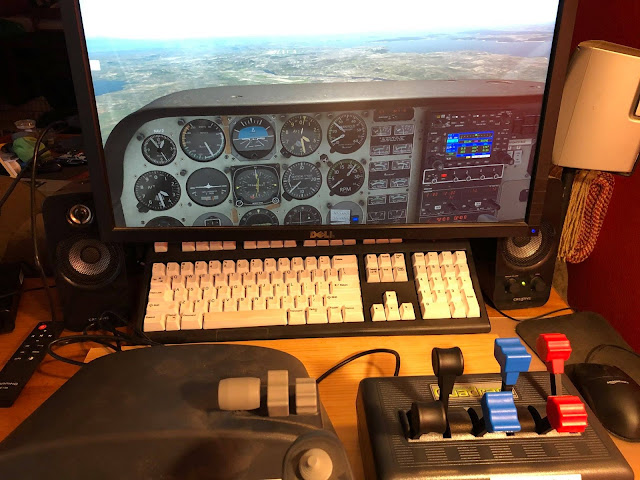Flight Simulator setup
I’ve dabbled in simulator flying for years, always with X-Plane. I built the below setup over Christmas 2019, never imagining my PP-AMEL add-on checkride would get constantly pushed out by a global pandemic. As it happened, I was able to practice instrument approaches and emergency procedure flows (including setting a MTBF for the engines, so I’d lose an engine when I wasn’t expecting it), and it was helpful during the months I was away from flying waiting for my checkride. (I did go up with my MEI for three intense sessions in the days before the finally scheduled practical exam, of course.)
My setup:
- CH Products Throttle Quadrant USB (really only necessary for multi-engine simulation) (and now that it’s out, I really wish I had the Bravo Throttle Quadrant (Amazon link)), but not that much)
- Honeycomb Alpha yoke (sold out on the Alpha site; Amazon link) (note, mine came with a discount coupon for X-Plane that I couldn’t take advantage of, since I’d already bought X-Plane). I originally started with the CH Products plastic yoke (seen below), but it was basically unusable, with a huge dead spot in pitch.
- CH Products Pro Pedals USB Flight Simulator Pedals that I’ve had forever. They’re okay.
- X-Plane 11 (Amazon link, 1 day shipping). I opted for the DVD version, because with all the scenery etc., that’s a lot to download and store locally.
- The Just Flight Duchess model.
- I had an old RAM cradle for an iPhone 6, and an unused old iPhone 6 that fit it. I didn’t want to spend a ton on name brand RAM stuff for this setup, so I picked up a <$20 generic claw kit that mates to the 1" RAM ball stuff perfectly. I have ForeFlight on it connected to X-Plane, and it’s great to have it right in front of me on the yoke. The Alpha’s shaft is a bit too narrow for the claw (which only goes down to .6") but there’s a big rubberized plastic round section of the yoke where the shaft connects that’s perfect for mounting the iPhone.
Wish list:
- If you’re doing any sort of IFR flying, a radio panel is almost a must (clicking the on-screen controls with the mouse cursor repeatedly to tune frequencies is a huge slog)
- A Garmin GNS430 interface.
- Maybe something like this, to hold an iPad dedicated to displaying the 6-pack? Flight Simulator Ipad Tablet Cockpit Stand Holder Sim Panel Honeycomb
Note the hardware requirements for this are hefty. I was able to get acceptable performance on a “2015” MacBook Pro:
- 2.2GHz quad-core Intel Core i7 processor (Turbo Boost up to 3.4GHz) with 6MB shared L3 cache
- 16GB of 1600MHz DDR3L RAM
- 256GB PCIe-based flash storage
- Intel Iris Pro Graphics
It ran, but not as well as you’d expect, on a Mac Pro with:
- 3.33 GHz 6-Core Intel Xeon
- 32 GB 1333 MHz DDR3 RAM
- Crucial CT1050MX300SSD1 on an OWC Accelsior S PCIe Adapter
- ATI Radeon HD 5870 1024 MB graphics (PCIe x16) (Edit: I should try it again now that it’s running a GTX 680.)
Likewise, especially for just practicing memory item checklists (e.g., the immediate steps taken in the event of a sudden loss of one engine in a multi-engine airplane), an older 2012 MacBook Air ran it well enough at minimum settings, though occasionally complained about frame rates:
- 1.8 GHz Core i5 (Ivy Bridge)
- 8GB RAM
- Integrated HD 4000 GPU
- Transcend JetDrive 240GB SSD upgrade
It worked “well enough” for what I wanted to do with it, but I haven’t really touched it since. Might start flying a bit with PilotEdge, since I have the sunk hardware and software costs, and more practice (especially with real ATC folks) is generally a Good Idea™.
X-Plane also integrates effortlessly with ForeFlight (iPad, iPhone, whatever, as long as it’s connected to the same network as the computer running X-Plane):
I haven’t had a chance to try out Microsoft’s Flight Simulator 2020; I’m a Mac guy, and don’t have Windows 10 anywhere. I’ve heard it’s visually beautiful but the actual physics of flying aren’t as accurate as X-Plane’s (which, to be fair, also have a lot of room for improvement; my landings in a real plane are nowhere near as all-over-the-place as those in X-Plane, even with what I’ve guesstimated to be reasonably accurate response curves for my controls).
Edit (9/14/2020): A CFI comparison of MSFS2020 vs. X-Plane 11 neatly summarizes: For serious flying, including IFR proficiency practice, X-Plane 11 is still the one to beat. Visually FS2020 is gorgeous, but:
- Flight models are all over the place (love the normally aspirated Baron climbing 3000 FPM at 18° pitch, and climbing through FL280);
- Garmin GPS avionics “implementation” in FS2020 is so incomplete as to be a deal breaker;
- Weather models suck and can't be configured for real IFR practice; and
- FS2020 is quite limited regarding available failure modes, for practicing emergency procedures.






Comments
Post a Comment